
The clarion calls for India’s self-reliance seem to face new challenges as the steel sector, a cornerstone of the nation’s industrial framework, stands imperiled by a significant rise in imports. In the financial year 2023-24, India, for the first time, became a net importer of steel—an alarming development that the industry views as a red flag for the country’s Atmanirbhar (self-reliant) aspirations.
According to the steel ministry’s Joint Plant Committee, the country has witnessed a startling 38 percent increase in its imports of finished steel, with figures skyrocketing to 8.319 million tonnes (MnT) compared to 6.022 MnT during the previous fiscal year 2022-23. This surge is primarily driven by an influx of steel from foreign markets, particularly China, which Indian industry experts describe as ‘predatory’ in nature.
Alok Sahay, the Secretary-General of the apex body Indian Steel Association (ISA), voiced the concerns of the industry, stating, “The surge in predatory imports from China is a big threat to the Atmanirbharta in steel. The country becoming a net importer is a warning signal to our march towards Atmnirbharta (self-reliance).”
This sentiment resonates across the Indian steel sector, with stakeholders and experts urgently calling for measures to curb these overwhelming imports. The demand for trade remedial actions is at an all-time high, and industry leaders insist that these measures must be implemented immediately to protect the domestic industry. Sahay further emphasized the need for regulatory revisions, pointing out that the current ‘lesser duty rule’ which benefits importers, should be discontinued to prevent countries with steel surpluses from capitalizing on India’s economic growth.
Echoing Sahay’s concerns, Ranjan Dhar, the Chief Marketing Officer of ArcelorMittal Nippon Steel, highlighted the threat that predatory imports pose to the Indian steel industry. Dhar insisted on the importance of restricting imports to protect investments and drive India’s GDP growth.
Anubhav Kathuria, the Director at Synergy Steels, added his perspective, especially in regards to the stainless steel segment, acknowledging the rise in imports from countries like China and Indonesia. Kathuria calls for strategic planning within the industry to boost cost competitiveness and suggests a reduction in import duties for critical raw materials such as ferro nickel, molybdenum concentrate, and ferro molybdenum to counter the current trends.
Amidst the mounting pressure from the industry, Vinod Kumar, President of India SME Forum, pointed out that there have been repeated pleas to the government to reevaluate the Free Trade Agreements with several countries to control imports effectively.
To meet its burgeoning needs and uphold the vision of self-reliance, India had previously set an ambitious target under the National Steel Policy, aiming to expand its annual steel production capacity to 300 million tonnes by 2030. This scalable vision is now confronting the stark reality of the international trade dynamics which threaten to impede India’s progress.
As India navigates through this critical juncture, the steel industry’s call to arms for Atmanirbharta echoes louder than ever. The government’s response to these concerns and the actions taken will not only determine the fate of the domestic steel industry but also signal how India adapts its economic strategies in the long quest to achieve self-reliance amidst global interdependencies. The solution, according to industry leaders, lies in a balanced approach that recognizes the threats of unregulated imports while simultaneously fostering an environment conducive to growth and self-sufficiency for the Indian steel sector.












